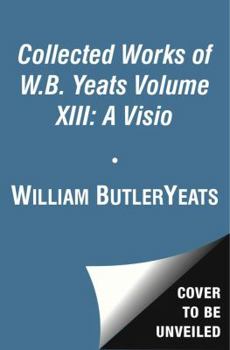The Collected Works of W.B. Yeats Volume XIII: A Vision: The Original 1925 Version
(Book #14 in the The Collected Works of W.B. Yeats Series)
Select Format
Select Condition 
Book Overview
The Collected Works of W. B. Yeats, Volume XIII: A Vision is part of a fourteen-volume series under the general editorship of eminent Yeats scholar George Bornstein and formerly the late Richard J. Finneran and George Mills Harper. One of the strangest works of literary modernism, A Vision is Yeats's greatest occult work. Edited by Yeats scholars Catherine E. Paul and Margaret Mills Harper, the volume presents the "system" of...
Format:Paperback
Language:English
ISBN:1476740887
ISBN13:9781476740881
Release Date:March 2013
Publisher:Scribner Book Company
Length:448 Pages
Weight:0.97 lbs.
Dimensions:1.3" x 5.5" x 8.3"
Customer Reviews
2 ratings
William Butler Yeats' A Vision Summarized
Published by Thriftbooks.com User , 17 years ago
One of the most remarkable channeled documents of the past century is Nobel Prize-winning poet William Butler Yeats' A Vision. Yeats explains how he obtained A Vision as follows: "On the afternoon of October 24th, 1917, four days after my marriage, my wife surprised me by attempting automatic writing. What came in disjointed sentences, in almost illegible writing, was so exciting, sometimes so profound, that I persuaded her to give an hour or two day after day to the unknown writer, and after some half dozen such hours offered to spend what remained of life explaining and piecing together those scattered sentences." Yeats spent the next twenty years on this project, and in the end produced a masterpiece which contains an all-encompassing system of symbolism which has geometrical, astrological, psychological, metaphysical, and historical components - a model of the entire universe: "all thought, all history and the difference between man and man." Yeats' theory of reincarnation as described in A Vision represents a novel view of the subject: that reincarnation does not take place within a matrix of linear time. It's not as if e.g. you had a life in ancient Greece and then you died; then you had a life in ancient Rome and then you died; then you had a life in the Middle Ages and then you died; etc. Rather, all of your past and future lives are going on at once, in an eternal Now moment. The linearity of time is an illusion, a falsehood, which Yeats termed Deception (and which Eastern philosophers term maya or samsara). It is this Deception, the false appearance that there is such a thing as an objective reality out there which is unfolding in linear time, which animates the striving of all sentient beings and keeps the wheel of reincarnation, of life and death and rebirth, turning. The basic geometrical symbol in A Vision represents the unraveling of time as two interpenetrating, rotating, heliacal cones (which Yeats terms gyres): "Incarnations and judgment alike implied cones or gyres, one within the other, turning in opposite directions." In Yeats' symbolism one of the rotating gyres represents Concord, or unity; the other gyre represents Discord, or desire. "Without this continual Discord through Deception there would be no conscience, no activity; Deception is a technical term of my teachers and may be substituted for `desire'". What is being symbolized by the two gyres is the driving force behind reincarnation - the descent into matter (Discord) and the return to spirit (Concord). By "Deception" Yeats means striving. Striving is not striving after something; desire is not desire for something. Rather striving and desire are movements, motions, for their own sake. It isn't really the objects of their desire which sentient beings seek but rather the hunger, the state of desire itself. The objects of desire - thought forms, the phenomenal world - don't have any objective existence. This is what is meant by the stateme
A Vision
Published by Thriftbooks.com User , 24 years ago
Readers of this book should be prepared to study. Yeats knowledge of mysticism is deep. He was a member of the Order of the Golden Dawn and had experience in conjuring in the British Museums with Assyrian artifacts. This book is based on a form of astrology, but not of the modern day "what's your sign " superficiality. Again readers must be prepared to do additional study, in the Vedas, the Gita, and Buddhist classics (start with DT Suzuki). This book ranks with Freud for its magnitude . Yeats has not been given the credit he deserves.





